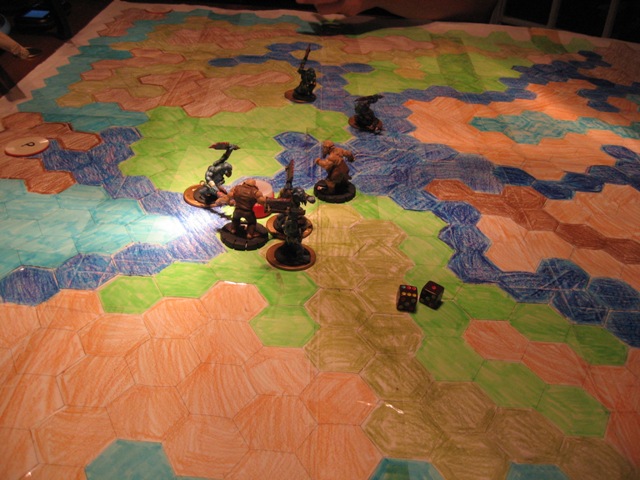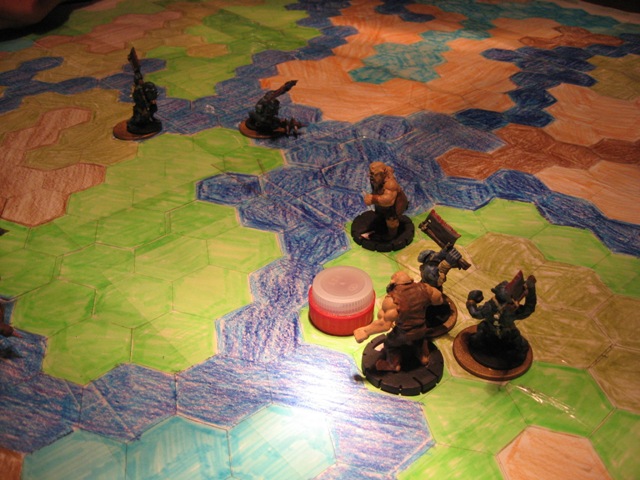Irrational Number Line Games, LLC
home stuff-to-buy idea archive about-us contact
Six-Color Hex Map
 This is a fairly simple project that shows how really cool and useful
simple ideas can turn out to be. At its base, this is nothing spectacular.
It's a hex map. I made a sheet of 1.5" hexes on my computer, printed it
out, and cut and taped them together into a big sheet. Then I colored
it in. With crayons. Obviously.
This is a fairly simple project that shows how really cool and useful
simple ideas can turn out to be. At its base, this is nothing spectacular.
It's a hex map. I made a sheet of 1.5" hexes on my computer, printed it
out, and cut and taped them together into a big sheet. Then I colored
it in. With crayons. Obviously.
What makes this map so useful that it keeps getting pulled back out year after year is the pattern. There are six colors ... or, more properly, three pairs of colors. Light and dark blue, light and dark brown, and light and dark green. Generally, these correspond to water, dirt, and vegetation.
A key piece of the design is that there are an equal number of hexes (or damn near) for each color. So "on the average" the colors are evenly distributed. But the pattern illustrates how useful "on the average" isn't in some situations...
The dark blue fractures out from the center, dividing the board into six roughly equal area, but irregularly shaped pieces. The light blue, skirts around the perimiter of the board, helping with the division.
I filled in the green by having it generally move away from the water, but didn't capture all the coastline, and then filled the remainder with the two shades of brown.
 The result is a map with "equal" amounts of terrain distributed, but prominent
features with lots of non-linearities. Even with just crayon in it, the
map looks a lot like a nice patch of natural terrain.
The result is a map with "equal" amounts of terrain distributed, but prominent
features with lots of non-linearities. Even with just crayon in it, the
map looks a lot like a nice patch of natural terrain.
The color coding is nice because it looks reasonably natural, but is still flexible to take different terrain characteristics, including dynamic ones. The simplest thing to do is to have a little chart with the terrain characteristics for each color.
The generic natural colors allow you a lot of leeway in assigning a variety of different characteristics to the terrain and still having things "look right". Light blue is "shallow water" ... maybe it has an effect on movement, maybe it is just another type of open terrain. Both "make sense", so when you explain it for the game you play, it will seem intuitive.
One of the things that prompted me to use six colors was the availability of blank d6. I've run some basic flooding scenarios - roll the die each turn, add a level of water to that type of terrain; all must reach one before any goes to two. For QILS this meant add one level of obstruction and one level of hindrance to that color terrain.
For a little more dynamic effect, I've played superhero games where the elevation of the different color terrain changed with the roll of a color die and a fudge die. Definitely a cinematic effect, but loads of fun for the right genre.
And, of course, there's no need to make dynamic terrain change randomly. You could have your flood (fire? earthquake?) progress from dark blue to dark green to dark brown to light brown to light green to light blue. Or whatever.
Anyway, there's a lot of legs on this simple and cheap to make "game mat" (is it really a game mat?). Different static terrain, dynamic terrain, and randomly changing terrain. Have fun!